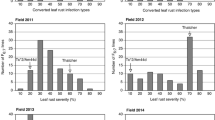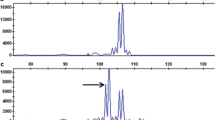Abstract
Intercross and backcross populations derived from aSolanum tuberosum L. (2n = 2x = 48) ×Solanum chacoense Bitt. (2n = 2x = 48) cross by selecting for resistance to potato leafhopper (PLH) (Empoasca fabae Harris), were tested in the field. In F2 and F4 populations, the levels of nymphal infestation and leaf necrosis from PLH feeding were considerably lower and tuber yields were much lower compared with those measured on the susceptible cultivar Kennebec. No differences were found between the two populations. Backcrosses of the F2 and F4 populations toS. tuberosum decreased resistance to PLH. Resistance to infestation was still greater than that of Kennebec; severity of leaf necrosis equaled that of Kennebec. Tuber yields increased, but were less than Kennebec’s yield. Foliage types shifted closer to those ofS. tuberosum. Three generations of selection and intercrossing within the backcross populations did not change the level of resistance to PLH but did tend to lower tuber yields. Foliage types remained primarilyS. tuberosum in appearance although distinctive types segregated with increased frequency. A second backcross toS. tuberosum did not change the level of resistance to PLH or the level of tuber yield relative to those of the first backcross or Kennebec.
Compendio
Se probaron en el campo poblaciones de intercruzamientos y retrocruzamientos obtenidas de un cruzamiento deSolanum tuberosum L. (2n = 2x = 48) ×Solanum chacoense Bitt. (2n = 2x = 48) al seleccionar para resistencia a la cigarrita de la papa (PLH) (Empoasca fabae Harris). En poblaciones F2 y F4, los niveles de infestatión de ninfas y de necrosis foliar por la alimentatión de la PLH fueron considerablemente más bajos y los rendimientos en tubérculos mucho menores en comparación con aquellos registrados sobre el cultivar susceptible Kennebec. No se observaron diferencias entre las dos poblaciones.
Los retrocruzamientos de las poblaciones F2 y F4 aS. tuberosum disminuyeron la resistencia a la PLH. La resistencia a la infestación fue aún mayor que aquella de Kennebec; la severidad de la necrosis foliar igualó a la de Kennebec. Los rendimientos en tubérculos se incrementaron, pero fueron menores que el rendimiento de Kennebec. Los tipos de follaje se hicieron más semejantes a aquellos deS. tuberosum. Tres generaciones de selección e intercruzamiento dentro de las poblaciones de retrocruzamiento no cambiaron el nivel de resistencia a PLH, pero tendieron a bajar los rendimientos en tubérculos. Los tipos de follaje permanecieron pareciéndose principalmente aS. tuberosum aun cuando tipos muy especiales segregaron con creciente frecuencia. Un segundo retrocruzamiento aS. tuberosum no cambió el nivel de resistencia a PLH o el nivel de rendimiento en tubérculos en relatión con el del primer retrocruzamiento o el de Kennebec.
Similar content being viewed by others
Literature Cited
Cantelo, W.W. and L.L. Sanford. 1984. Insect population response to mixed and uniform plantings of resistant and susceptible plant materials. Environ Entomol 13:1443–1445.
Hawkes, J.G. 1990. The potato. Evolution, biodiversity, and genetic resources. Smithsonian Institution Press, Washington, D.C. 259p.
Healy, M.J.R. and H.R. Taylor. 1962. Tables for power-law transformations. Biometrika 49:557–559.
Horsfall, J.G. and R.W. Barratt. 1945. An improved grading system for measuring plant diseases. Phytopathology 35:655.
Kalazich, J.C. 1989. Introgression of the trichome characteristics ofSolanum berthaultii (Hawkes) intoS. tuberosum (L.) Ph.D. Thesis, Cornell University, Ithaca, NY.
Radcliffe, E.B. and F.I. Lauer. 1968. Resistance toMyzus persicae (Sulzer),Macrosiphum euphorbiae (Thomas), andEmpoasca fabae (Harris) in the wild tuber-bearingSolanum (Tourn) L. species. Minn Agric Stn Bull 259.
Sanford, L.L. and J.P. Sleesman. 1970. Genetic variation in a population of tetraploid potatoes: Response to the potato leafhopper and the potato flea beetle. Am Potato J 47:19–34.
Sanford, L.L. and R.E. Webb. 1977. Loss of yield in potato selections infested with potato leafhoppers. Am Potato J 54:581–586.
Sanford, L.L. 1979. Effect of random mating on yield and specific gravity in twoSolaman tuberosum subsp.tuberosum populations. Am Potato J 56:597–607.
Sanford, L.L. and T.L. Ladd, Jr. 1987. Recurrent selection of potato leafhopper resistance in potato,Solanum tuberosum L. Gp.Tuberosum. Am Potato J 64:367–376.
Sarle, W.S. 1983. The cubic clustering criterion. SAS Technical Report A-108. SAS Institute Inc., Cary, NC.
SAS/STAT Guide, Version 6. 1987. SAS Institute Inc., Cary, N.C.
Sleesman, J.P. 1940. Resistance in wild potatoes to attack by the potato leafhopper and the potato flea beetle. Am Potato J 17:9–12.
Tingey, W.M. and R.L. Plaisted. 1976. Tetraploid sources of potato resistance toMyzus persicae, Macrosiphum euphorbiae, andEmpoasca fabae. J Econ Entomol 69:673–676.
Author information
Authors and Affiliations
Rights and permissions
About this article
Cite this article
Sanford, L.L., Ladd, T.L. Performance of populations derived by selecting for resistance to potato leafhopper in A 4XSolanum Tuberosum X 2XSolanum Chacoense cross. American Potato Journal 69, 391–400 (1992). https://doi.org/10.1007/BF02877490
Accepted:
Issue Date:
DOI: https://doi.org/10.1007/BF02877490




